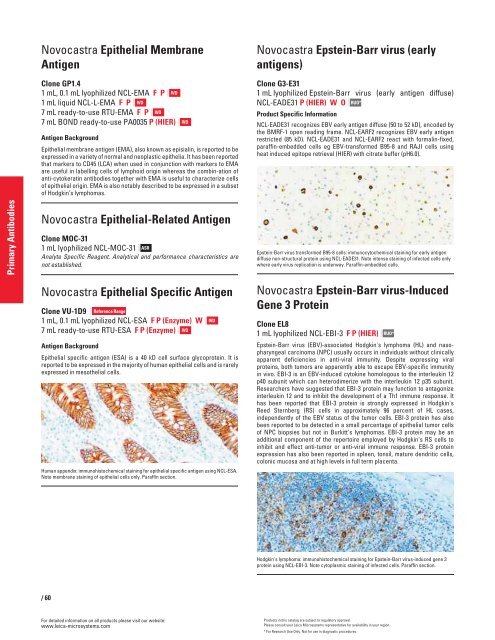QF0159 Marketing Release Record
QF0159 Marketing Release Record
QF0159 Marketing Release Record
Create successful ePaper yourself
Turn your PDF publications into a flip-book with our unique Google optimized e-Paper software.
Primary Antibodies<br />
Novocastra Epithelial Membrane<br />
Antigen<br />
Clone GP1.4<br />
1 mL, 0.1 mL lyophilized NCL-EMA FP<br />
1 mL liquid NCL-L-EMA FP IVD<br />
7 mL ready-to-use RTU-EMA FP IVD<br />
7 mL BOND ready-to-use PA0035 P (HIER)<br />
Antigen Background<br />
Epithelial membrane antigen (EMA), also known as episialin, is reported to be<br />
expressed in a variety of normal and neoplastic epithelia. It has been reported<br />
that markers to CD45 (LCA) when used in conjunction with markers to EMA<br />
are useful in labelling cells of lymphoid origin whereas the combin-ation of<br />
anti-cytokeratin antibodies together with EMA is useful to characterize cells<br />
of epithelial origin. EMA is also notably described to be expressed in a subset<br />
of Hodgkin’s lymphomas.<br />
Novocastra Epithelial-Related Antigen<br />
Clone MOC-31<br />
1 mL lyophilized NCL-MOC-31 ASR<br />
Analyte Specific Reagent. Analytical and performance characteristics are<br />
not established.<br />
Novocastra Epithelial Specific Antigen<br />
Clone VU-1D9 Reference Range<br />
1 mL, 0.1 mL lyophilized NCL-ESA F P (Enzyme) W<br />
7 mL ready-to-use RTU-ESA F P (Enzyme) IVD<br />
Antigen Background<br />
Epithelial specific antigen (ESA) is a 40 kD cell surface glycoprotein. It is<br />
reported to be expressed in the majority of human epithelial cells and is rarely<br />
expressed in mesothelial cells.<br />
Human appendix: immunohistochemical staining for epithelial specific antigen using NCL-ESA.<br />
Note membrane staining of epithelial cells only. Paraffin section.<br />
/60<br />
For detailed information on all products please visit our website:<br />
www.leica-microsystems.com<br />
IVD<br />
IVD<br />
IVD<br />
Novocastra Epstein-Barr virus (early<br />
antigens)<br />
Clone G3-E31<br />
1 mL lyophilized Epstein-Barr virus (early antigen diffuse)<br />
NCL-EADE31 P (HIER) W O RUO*<br />
Product Specific Information<br />
NCL-EADE31 recognizes EBV early antigen diffuse (50 to 52 kD), encoded by<br />
the BMRF-1 open reading frame. NCL-EARF2 recognizes EBV early antigen<br />
restricted (85 kD). NCL-EADE31 and NCL-EARF2 react with formalin-fixed,<br />
paraffin-embedded cells eg EBV-transformed B95-8 and RAJI cells using<br />
heat induced epitope retrieval (HIER) with citrate buffer (pH6.0).<br />
Epstein-Barr virus transformed B95-8 cells: immunocytochemical staining for early antigen<br />
diffuse non-structural protein using NCL-EADE31. Note intense staining of infected cells only<br />
where early virus replication is underway. Paraffin-embedded cells.<br />
Novocastra Epstein-Barr virus-Induced<br />
Gene 3 Protein<br />
Clone EL8<br />
1 mL lyophilized NCL-EBI-3 F P (HIER)<br />
RUO*<br />
Epstein-Barr virus (EBV)-associated Hodgkin's lymphoma (HL) and nasopharyngeal<br />
carcinoma (NPC) usually occurs in individuals without clinically<br />
apparent deficiencies in anti-viral immunity. Despite expressing viral<br />
proteins, both tumors are apparently able to escape EBV-specific immunity<br />
in vivo. EBI-3 is an EBV-induced cytokine homologous to the interleukin 12<br />
p40 subunit which can heterodimerize with the interleukin 12 p35 subunit.<br />
Researchers have suggested that EBI-3 protein may function to antagonize<br />
interleukin 12 and to inhibit the development of a Th1 immune response. It<br />
has been reported that EBI-3 protein is strongly expressed in Hodgkin's<br />
Reed Sternberg (RS) cells in approximately 96 percent of HL cases,<br />
independently of the EBV status of the tumor cells. EBI-3 protein has also<br />
been reported to be detected in a small percentage of epithelial tumor cells<br />
of NPC biopsies but not in Burkitt's lymphomas. EBI-3 protein may be an<br />
additional component of the repertoire employed by Hodgkin's RS cells to<br />
inhibit and effect anti-tumor or anti-viral immune response. EBI-3 protein<br />
expression has also been reported in spleen, tonsil, mature dendritic cells,<br />
colonic mucosa and at high levels in full term placenta.<br />
Hodgkin's lymphoma: immunohistochemical staining for Epstein-Barr virus-induced gene 3<br />
protein using NCL-EBI-3. Note cytoplasmic staining of infected cells. Paraffin section.<br />
Products in this catalog are subject to regulatory approval.<br />
Please consult your Leica Microsystems representative for availability in your region.<br />
* For Research Use Only. Not for use in diagnostic procedures.
















